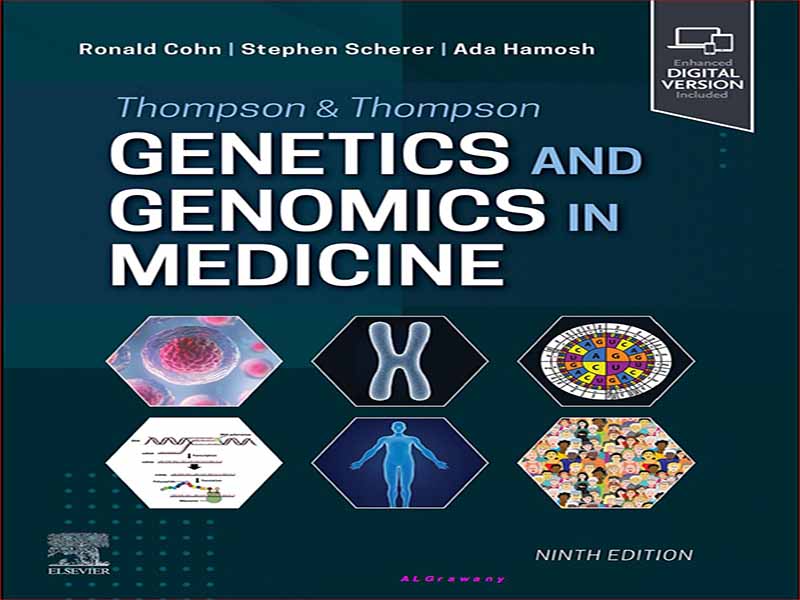- عنوان کتاب: THOMPSON & THOMPSON GENETICS AND GENOMICS IN MEDICINE
- نویسنده: Ronald Doron Cohn
- حوزه: ژنتیک
- سال انتشار: 2024
- تعداد صفحه: 612
- زبان اصلی: انگلیسی
- نوع فایل: pdf
- حجم فایل: 39.4 مگابایت
ما تا حدودی با اکراه موافقت کردیم که سه ویراستار جدید برای ویرایش نهم ژنتیک در پزشکی باشیم که از سال 1966 در جریان بوده است. (کار و زندگی) در طول مسیر. این موضوع به حیطه کاری که مطمئناً درگیر آن است نیز ربطی نداشت. عدم اطمینان ما واقعاً با تردیدهایی مرتبط بود که میتوانیم کتابی را مطابق با استانداردهای مؤلفان مؤسس، جیمز اس. تامپسون (1919-1982) (نسخههای 1-3) و مارگارت دبلیو. تامپسون («پگی») (1920) ارائه کنیم. -2014) (نسخه های 1-5)، و جانشینان آنها (نسخه های 6-8)، رودریک مک اینز (ویرایش 5 با پگی تامپسون) و نسخه های بعدی 6-8)، رابرت نوسبام (نسخه های 6-8)، و هانتینگتون ویلارد ( نسخه های 5-8). ما همچنین نگران بودیم که چگونه ما سه نفر به تنهایی میتوانیم مجموعه عظیمی از ادبیات در زمینه ژنتیک پزشکی و ژنومیک را که در طول دورهای از انتشار نسخه هشتم پدید آمده بود، پوشش دهیم. ما رویکرد آزمایششده «ایستادن روی شانهها» را در پیش گرفتیم، که اندکی از اصول اصلی و بهخوبی نوشتهشده ژنتیک پزشکی کتاب را تغییر دادیم. فن آوری ها بیشتر جزء در حال تکامل بوده اند. زمانی که ویرایشهایی انجام دادیم، از دانش خود در این زمینه استفاده کردیم، ادبیات و پایگاههای اطلاعاتی (که برخی از آنها را نظارت میکنیم) را موشکافی کردیم و با کارشناسان مشورت کردیم. حتی همانطور که خودمان انجام داده بودیم، برخی از این کارشناسان در نسخه های قبلی مشارکت داشتند، اما برای بسیاری این یک تجربه جدید بود. ابراز قدردانی از اینکه از او خواسته شد بخشی از این ابتکار عمل باشد، نشان دهنده وضعیتی است که این کتاب هنوز در جامعه حرفه ای دارد. برای اولین بار، ما این مشارکتها را از طریق همنویسندگی یا قدردانی خاص اعتبار میدهیم – کاری که فکر میکردیم درست است. در عین حال، ما و آنها پایههایی را که مشارکتکنندگان در نسخههای قبلی گذاشتهاند، تصدیق میکنیم. به این نسخه از آنچه که این رشته به طور محبوب «تامپسون و تامپسون» مینامد، برخی از محتوای در حال تکامل را اصلاح کردهایم، از جمله: (1) حرکت از مطالعه ژنها به ژنوم در زیستشناسی و آزمایش، (2) افزایش آگاهی از تعداد نسخهها و ساختار تنوع ژنومی هم در جامعه و هم در زمینه ژنومی پزشکی، (3) اکتشافات جدید و کاربرد نقش های عملکردی RNA های غیر کدکننده، تنظیم کروماتین و اپی ژنتیک، و اینکه چگونه بی نظمی آنها می تواند بر بیان ژن در بیماری تاثیر بگذارد، (4) تنوع ژنتیکی در جمعیتهای سراسر جهان، (5) آخرین فناوریها (مانند توالییابی ژنوم) و رویکردهای آماری/انفورماتیکی، مانند امتیاز خطر چند ژنی، برای حل و تفسیر آنها استفاده میشود، و (6) بسیاری از تشخیصهای ژنتیکی جدید ناشی از کاربرد این اصول جدید و فن آوری ها (به عنوان مثال، سندرم های ژنومی و سیلوپاتی). هر فصل هنوز با سؤالاتی بسته می شود که خواننده را به تحکیم مطالب در عمل، شاید برای آمادگی برای امتحانات، همراه با پاسخ های جامع، به چالش می کشد. موارد بسیار محبوب بالینی – برای اولین بار در ویرایش ششم برای نشان دادن اصول کلی وراثت، پاتوژنز، تشخیص، مدیریت و مشاوره معرفی شدند – با نظرات متخصصان بیشتر به طور کامل به روز یا گسترش یافتند. آنها چالشهای بیان متغیر، پلیوتروپی و اختلالات پیچیده را همانطور که به پزشکان ژنتیک پزشکی در این زمینه ارائه میدهند، به تصویر میکشند. ما بیش از همه به تلاش های خود برای به تصویر کشیدن این نسخه از ژنتیک در پزشکی، اکنون ژنتیک و ژنومیکس در پزشکی از دریچه جامعه ای که به شدت در نحوه دسترسی، تفسیر و انتقال اطلاعات تغییر کرده است، افتخار می کنیم. به عبارت ساده، ژنتیک یک علم اطلاعات است: DNA، RNA و پروتئین ها، و شبکه ها و ترکیبات آنها، زیربنای زیست شناسی ما در سلامت و بیماری است. ما تمام تلاش خود را انجام دادیم تا دانش جدید را از ورای اصول جزمی به دست آوریم، اما شاید مهمتر از آن، تلاش کردیم تا اطلاعات را در زمینه زمینه سازی کنیم زیرا هم پزشکی و هم جامعه اکنون می خواهند از آن استفاده شود. برای مثال، برای بهروزرسانی برخی از تصاویر شرایط ژنتیکی، از سازمان غیرانتفاعی Positive Exposure درخواست کردیم تا عکسهایی از مجموعه داوطلبان خود ارائه دهد. این سازمان با گروههای مختلف حمایت از ژنتیک کار میکند تا افرادی را که با تفاوتهای ژنتیکیشان زندگی میکنند به شیوههایی که محترمانه، فراگیر و آشکارا زیبا هستند، نشان دهد. در جایی که از نام استفاده می شود، به درخواست آنها است. ما همچنین دستورالعمل های به روز شده ای را برای زبان و اصطلاحات، به ویژه برای کلماتی مانند نژاد، قومیت، چندشکلی، و جهش گنجانده ایم (اصطلاح “جهش” در زمان نگارش 590 بار در این نسخه و بیش از 1000 بار در آخرین نسخه استفاده شده است!). ما همچنین بخشهای جدیدی را گنجاندهایم که استفاده (و نیاز به) اطلاعات ژنتیکی را در مطالعه جمعیتهای بومی و بنیانگذار منحصربهفرد توصیف میکند. ناشران همچنین به بهبود نسخه کتاب الکترونیکی همراه با گسترش گزینههای جستجوی تمام متنها، شکلها و مراجع در دستگاههای مختلف ادامه دادهاند.
We agreed somewhat reluctantly to take on the assignment to be three new editors for the 9th Edition of the acclaimed Genetics in Medicine, which has been in circulation since 1966. Our hesitancy had nothing to do with a looming pandemic, about to throw up major obstacles (work and life) along the way. Nor did it have to do with the scope of work sure to be involved. Our uncertainty really had to do with doubts that we could ever deliver a book to the standards of the founding authors, James S. Thompson (1919-1982) (Editions 1-3) and Margaret W. Thompson (“Peggy”) (1920-2014) (Editions 1-5), and their successors (Editions 6-8), Roderick McInnes (Edition 5 with Peggy Thompson) and later Editions 6-8), Robert Nussbaum (Editions 6-8), and Huntington Willard (Editions 5-8). We also worried how we three alone could cover the immense body of literature in medical genetics and genomics that had arisen over the period since the 8th Edition was released. We took the time-tested approach of “standing on shoulders”, changing little of the book’s well-covered and well-written core principles of medical genetics. Technologies have been more of an evolving component. When we did make edits, we drew from our own knowledge in the field, scrutinized the literature and databases (some of which we oversee), and consulted experts. Even as we ourselves had done, some of these experts had contributed to earlier editions, but for many it was a new experience. The expressions of gratitude at being asked to be part of the initiative spoke to the status this book still holds in the professional community. For the first time, we credit these contributions through co-authorship or specific acknowledgement—something we thought was right to do. At the same time, we and they acknowledge the foundations laid out by the contributors to earlier editions. To this version of what the field endearingly calls “Thompson and Thompson”, we have amended some evolving content, including: (1) moving from the study of genes to genomes in biology and testing, (2) increasing awareness of copy number and structural genomic variation in both the population and medical genomic context, (3) novel discoveries and application of the functional roles of non-coding RNAs, chromatin-regulation and epigenetics, and how their dysregulation can affect gene expression in disease, (4) genetic variation in worldwide populations, (5) latest technologies (e.g., genome sequencing) and statistical/informatics approaches, such as polygenic risk scores, used to resolve and interpret them, and (6) the many new genetic diagnoses arising from application of these new principles and technologies (for example, genomic syndromes and ciliopathies). Each chapter still closes with questions that challenge the reader to consolidate the material into practice, perhaps in preparation for exams, along with comprehensive answers. The highly popular Clinical Cases—first introduced in the sixth edition to demonstrate the general principles of inheritance, pathogenesis, diagnosis, management, and counseling—were entirely updated or expanded with input from yet more experts. They capture the challenges of variable expression, pleiotropy, and complex disorders as they present to medical genetics practitioners in the field. We are most proud of our efforts to portray this edition of Genetics in Medicine, now Genetics and Genomics in Medicine through the lens of a society that has changed drastically in how it accesses, interprets, and communicates information. Simply put, genetics is an information science: the DNA, RNA and proteins, and their networks and combinations, underlie our biology in health and disease. We made every attempt to capture the new knowledge from beyond the central dogma, but perhaps more importantly, we strove to contextualize the information as both medicine and society now want it to be applied. For example, to update some of the illustrations of genetic conditions, we asked the not-for-profit organization, Positive Exposure, to contribute photographs from their portfolio of volunteers. The organization works with various genetics support groups to present individuals living with their genetic differences in ways that are respectful, inclusive, and frankly beautiful. Where names are used, it is at their request. We also incorporated updated guidelines for language and terminology, notably for words such as race, ethnicity, polymorphism, and mutation (the term “mutation” at time of writing was used ~590 times in this edition and over 1000 in the last!). We also included new sections describing the use (and need for) genetic information in the study of unique indigenous and founder populations. The publishers have also continued to enhance the accompanying eBook version which by expanding the search options of all the text, figures, and references on a variety of devices.
این کتاب را میتوانید بصورت رایگان از لینک زیر دانلود نمایید.
Download: THOMPSON & THOMPSON GENETICS AND GENOMICS IN MEDICINE




































نظرات کاربران